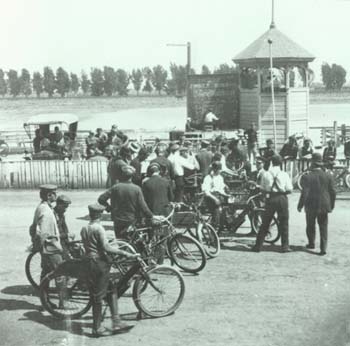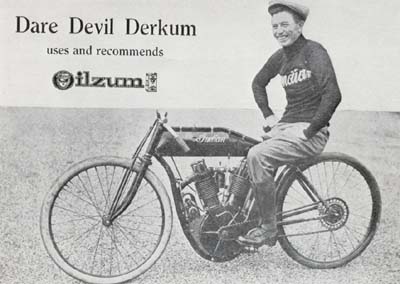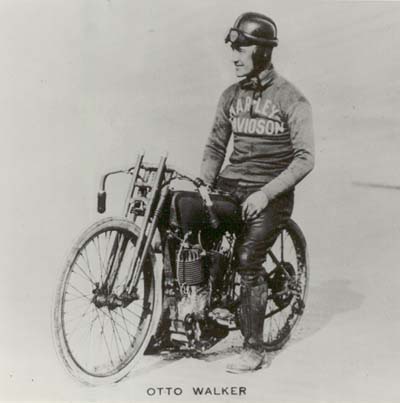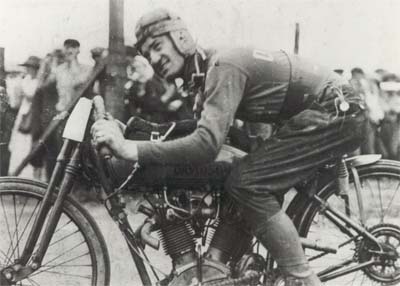by Daniel K. Statnekov |
| ©1998 - 2006 Daniel K. Statnekov |
|
In the first major event of 1915, Harley-Davidson continued their aggressive
competition campaign against their main rivals. On April 4th, a
highly publicized Venice, California 300-mile road race drew as strong a
field as had ever contested any American race.
All of the big stars from the top three, as well as factory-sponsored teams
from five other manufacturers, including the newest sensation the overhead-cam
Cyclone, were represented. Unlike most road races, which were chiefly
endurance competitions between distant cities, this was a race over a
measured course through the Venice, California city streets.
Paul "Dare Devil" Derkum was the promoter of the event. Derkum had earned his nickname in 1908 by setting records at the old Agricultural Park 1-mile dirt track in Los Angeles. When Jack Prince built the L.A. Coliseum Motordrome in 1909, the local star was among the first to ride the boards. He continued to compete, and in 1913 came out on top in the first running of the "treacherous" San Diego to Phoenix Desert Race.
Employed by the railroad as a fireman on the night train, Derkum worked during the day as the manager of Jack Prince's Coliseum motordrome. The young man's industrious nature caught the eye of the board track impresario who gave his manager the added responsibility to supervise the construction of several of his board track designs. Eventually, Paul Derkum became a race promoter himself. By 1915, he was already an important figure in the racing game. For this 300-mile race, Derkum secured the cooperation of Venice city officials as well as the Mayor of the City of Los Angeles. His political connections enabled the popular race promoter to lay out a course on Venice city streets. In addition to resurfacing the streets over which the race would be run, the city of Venice relocated powerlines and a railroad station to improve course safety. Included in the 3-mile course, were mildly-banked, wooden-surfaced turns which Derkum constructed out of sections of the recently dismantled Playa del Rey board track which had suffered a major fire in 1913. With an estimated 12,000 spectators in attendance, the riders were flagged off to a fast start on Derkum's creation: a race over city streets that featured long concrete straightaways and banked wooden turns.
The Harley-Davidson team was led by Harry "Otto" Walker who throughout his
life was always called "Otto." Born in Lathrop, California on the 4th
of July in 1890, the man who was elected "Captain" by his fellow teammates
began his racing career in 1911 on one of those "fast" ported Excelsiors that
did so well that year. Walker's first race, in July of 1911, didn't exactly
bring home the bacon, but the affable Californian with the easy smile was
rewarded with a turkey for his 4th place showing.
Gaining experience at Oakland's 1/2-mile Oakhurst motordrome, Walker continued to improve, winning the Western Federation of Motorcyclists' 10-mile amateur championship in 1913. Before joining Harley-Davidson in 1914, Walker teamed up with Erle "Red" Armstrong and "Dud" Perkins, riding the financially rewarding, rough-and-tumble California race circuit on "ported" Excelsiors. Like H-D's "older" team captain, Leslie "Red" Parkhurst had also been hired by Harley-Davidson in 1914. Born in 1896, Parkhurst was only 13 years-old when he began his career in 1909 at the old Tuilleries board track in Denver, Colorado. By 1912, the likeable youngster had graduated from the school of hard knocks. Turning professional, he rode the boards in Dallas, St. Louis, and Milwaukee.
While riding at the Milwaukee motordrome in 1914, the 18 year-old
"seasoned" professional was asked to try out Bill Ottaway's new race
motor. The motor was fast enough and Parkhurst handled it well,
so H-D hired him to ride at Dodge City. Subsequently, the Milwaukee
company signed up other riders for that historic 4th of July race, but
the scrappy young motordrome jockey, Leslie "Red" Parkhurst, could
claim the distinction of being the very first member of the Harley-Davidson team.
For the 1915 Venice race, the H-D factory fielded four entry's with machines that featured improved engines developed by Bill Ottaway the previous winter. Parkhurst and Walker jumped ahead at the start, and throughout the race maintained a safe lead over their nearest rivals. Seldom separated from each other by more than a few feet, the two leaders dashed by the spectator stands neck and neck, and appeared more like bitter rivals than teammates. Parkhurst led for the first 270 miles; then the two Harley riders began a battle for the lead--Walker finally gaining the advantage. The winning time of just over 69 mph set a new record for the 300-mile distance. When he rolled into the pits at the finish, it was discovered that the front of Walker's machine was covered with blood. The H-D team captain explained that his neck had become very stiff in the closing stages of the race. When he tried to rest his head on the handlebars, the vibration had bloodied his nose. With Walker's victory and Parkhurst's second place showing, Venice was Harley-Davidson's first win at a major race. Excelsiors had placed 3rd and 4th with Indian riders finishing 5th and 6th, while both Cyclones had suffered mechanical failures. There was cause for celebration in Milwaukee, Ottaway's improved motor, and the newly formed team that the H-D engineer had assembled for his company, had beaten the best machines and the best riders that their competition could field. |
|
|
|
|
|
Webmaster: daniels@statnekov.com |
Page installed: Nov. 15, 1996 Page revised: June 28, 2003 |



